Report highlights:
- Peaceful solo protests last month by three monks in the Tibetan region of Amdo who have now disappeared are the most recent occurrences of an act of remarkable courage that has become a trend in eastern Tibet since around 2014. This trend seems linked to a wish by protestors to make a strong statement about freedom and loyalty to the Dalai Lama without undertaking the more extreme act of self-immolation.
- Most of the solo protests documented by the International Campaign for Tibet have occurred in Ngaba (Chinese: Aba), Sichuan, since 2014—the same area where the wave of self-immolations began in 2009 when Tapey, a monk of Kirti Monastery, set himself on fire. Not only were most of the self-immolations carried out in the same county town, but also in the same road—which has come to be known as Heroes, or Martyrs, Street—by monks from the same monastery.
- As the frequency of self-immolations decreased in Ngaba in the period of 2014-2018, the number of solo protests has increased. The desire to protect families and friends from the repercussions that follow self-immolations (which can also be characterized as solo protest of a different form) is likely to be a factor in this new type of protest. The Chinese authorities have responded to the more than 150 self-immolations in Tibet with an intensified wave of repression and by punishing those allegedly ‘associated’ with those who set themselves on fire, including friends, families and entire communities.
- The Tibetans who have carried out solo protests, often while holding an image of the Dalai Lama or clasping their hands together in prayer, know that even without self-immolation, they face life-threatening, brutal treatment in prison. Like self-immolation, it is an act emerging from the anguish of oppression as well as a strong statement about Tibetan values, resilience and continued resistance to Chinese policies, whatever the personal cost. The continuation of these acts also indicates the failure of the Chinese authorities to extinguish loyalty to the Dalai Lama even in a climate of intensified repression.
- There appears to be a correlation between the occurrence of solo protests in two areas, mostly Ngaba (Aba) and Kardze (Ganzi), and high levels of securitization. In 2016, per capita domestic security expenses in Tibetan areas of Sichuan were nearly three times higher than for Sichuan province as a whole. Domestic security spending in Ngaba and Kardze, which have both also seen numerous self-immolations, grew by 295 percent between 2007 and 2016.[1]
This report details 38 solo protests by Tibetans from 2014 to October 4, 2018, comprising four so far in 2018, five in 2017, six in 2016, 17 in 2015 and six in 2014. Other protests may have occurred that are not known to the International Campaign for Tibet, given the tight constraints placed by Chinese authorities on information and the dangers Tibetans face in sharing news from inside Tibet.
Analysis of the protests reveals the impact of self-immolations on the broader Tibetan community, and in some cases, personal connections with those who self-immolated and their families, indicating a knowledge of the severe consequences self-immolators have faced. Measures adopted in 2012 in response to self-immolations across Tibet have resulted in a spike in political imprisonments, including one instance of the death penalty, and numerous cases of Tibetans being ‘disappeared’, with family and friends unaware of whether or not they are still alive, often for weeks or months.[2]
Sixteen of the solo protesters are monks (and two more are former monks) from Kirti, one of the most influential monasteries and centers of learning in the region, which has been subject to a particularly harsh crackdown since the first self-immolation in 2009 – which may be a strong motivating factor in the demonstrations. Twenty-six of the 38 solo protests monitored took place on what is now known as ‘Heroes Street’ in Ngaba (Chinese: Aba), which is the road from the monastery into the main town, the location of the first self-immolation by Tapey on February 27, 2009. Seven monks from Kirti monastery who carried out solo protests in 2015 were of the same generation as many of those who self-immolated, and may have known some of the self-immolators; two had family connections to Tibetans who are already in prison.
A Kirti monk living in Dharamsala, India, Kanyag Tsering, said: ‘Many of the self-immolators and solo protestors were born in the same areas and are of a similar age, mostly in their twenties. Often they studied at the same monasteries. Some of the solo protesters may have known those who self-immolated, even just as a passing acquaintance.”
Tibetans have deep respect for those who carry out these solo protests. A Tibetan from Amdo, now working in exile as a researcher, said: “Those determined people who carry out such a protest must have surely calculated the outcome, in terms of the treatment they will receive. Self-immolation can end one’s life right away, but the most bitter part for the solo protesters is what will happen to them afterwards. There is no doubt that the repressive environment in Ngaba is a huge factor in their drive to express their feelings.”
Others have noted the different form of protest. A Tibetan from Ngaba who attended the funeral rites for Phuntsog, who set fire to himself on March 16, 2011, said: “These young Tibetans who have protested [in solo demonstrations in Ngaba] are so determined, and courageous, and it is so good to see that they are not harming themselves [by carrying out self-immolation.]”
The most recent self-immolation in Tibet, on March 7 (2018), occurred in Me’uruma, Ngaba county, Ngaba Tibetan and Qiang Autonomous Prefecture, the first in 2018. A Tibetan man in his forties, Tsekho Tugchak, set fire to himself on March 7 (2018) and died at a time of intense securitization across Tibet in the buildup to the sensitive anniversary of the March 10 Uprising in 1959, and the tenth anniversary of protests that swept across Tibet in 2008 on the same date. It was the 153rd self-immolation in Tibet since 2009.[3]
Three days before the self-immolation, on March 4 (2018), the Chinese authorities had underlined how their strategies to prevent self-immolations rely upon oppressive measures. At a meeting in Chamdo (Chinese: Changdu) in the Tibet Autonomous Region, officials heard that in order to “prevent self-immolations”, it is necessary for Party officials to maintain tough repressive measures already in place, and also to ensure “their absolute loyalty to the CPC Central Committee with Comrade Xi Jinping as the core”.[4] This is reflected in security expenditures in these areas; since 2008, when the wave of overwhelmingly non-violent protests spread across Tibet, Sichuan’s Tibetan regions have had the highest per capita domestic security expenditure of all provinces and regions in the PRC, together with Beijing. The Tibet Autonomous Region had the highest per capita domestic security expenditure during this period.[5]
The self-immolation that took place before that, in December, 2017, was also in Ngaba. A young Tibetan man called Konpe set fire to himself on December 23 (2017) and died in Ngaba, close to the site of the first self-immolation in Tibet eight years ago.[6]
There have been clusters of solo protests in Me’uruma (Chinese: Mai’erma Xiang), a township not far from Ngaba county town and in the same prefecture. In 2015, three lay women, Wangmo, Tashi Kyi, and Wokar Kyi, made solo protests there over a period of several weeks in the summer.
Despite the already intense repression, solo protests are generally followed by the imposition of even more severe security measures, according to reports of the incidents documented below. In Ngaba, sometimes protesters have been barely able to shout a full sentence before being detained, often brutally, and dragged away by police.
Some solo protesters have chosen to mark specific anniversaries through their demonstrations – anniversaries that have also been marked by self-immolators. For instance, Kirti monk Lobsang Dargye called out for the return of the Dalai Lama to Tibet, and for freedom, on March 16, 2017, the anniversary of a major crackdown in Ngaba following protests in 2008. It has been marked in previous years by Tibetans setting fire to themselves, including two Kirti monks on March 16, 2014.[7]
An official involved in crushing protest activity in Ngaba from 2007 to 2012, Shi Jun, has recently been promoted to deputy head of the United Front Work Department in Beijing. In a rare posting, a Party cadre raised alarm about the level of securitization and intimidation in Ngaba, where most of the solo protests have occurred, under Shi Jun’s watch, calling him “lord of monsters”. In 2012, at the height of the wave of self-immolations, a Tibetan cadre named as Luo Feng wrote about the then Communist Party Secretary of Ngaba, Shi Jun’s leadership, saying: “There is a saying among the people: the practice of one guard every three paces and a sentry post every five paces is just like Iraq, the practice of more members of the working team than the number of monks is like the Cultural Revolution, and the practice of having the common people live under the gun is like Libya.”[8]
Sometimes solo protests are made following self-immolations. Two months before Losang Tenpa and Losang Gyatso’s protests, on February 14, in 2014, a former Kirti monk called Lobsang Dorje, 25, died after setting himself on fire in the same location.[9]
Not all solo protesters are monks; from 2014-18, seven were carried out by laywomen, mostly in Ngaba. The other area of Tibet where there have been a number of solo protests since 2014 is Kardze (Chinese: Ganzi) Tibetan Autonomous Prefecture, also in Sichuan, the Tibetan area of Kham. ICT has documented six solo protests in the prefecture, all by laypeople.
The political climate in Kardze Tibetan Autonomous Prefecture has been particularly tough, reflecting its history of resistance to Chinese rule and the continued strong sense of Tibetan identity and culture. In various official reports, the Chinese authorities have indicated that it is an “arduous” struggle to “maintain public order and safeguard stability” in Kardze, an oblique reference to the high number of peaceful protests and dissent in the region, and continued loyalty to the Dalai Lama.[10]
Only one of the solo protests detailed in this report involved the demonstrator harming themselves; a Tibetan man reportedly cut his throat after calling for freedom for Tibet in Lhasa on June 23, 2017.
Little information is known immediately after the event about the fate of Tibetans who carry out solo protests. New information about some of the imprisoned solo protesters in Ngaba emerged from two Kirti monks in exile in Dharamsala, India, recently. Kanyag Tsering and Lobsang Yeshe said that some of those arrested in 2014-5 in Ngaba are now gradually being released after two or three year sentences. The exiled monks said in an email communication: “The village police stations are then taking them back into detention for a week or so, saying they need reeducation. For example, Kirti monk Losang Kelsang was released on September 17 [2018], and then detained by the Me’uruma police for five days. Kirti monk Jampal Gyatso was also released in September and then detained for a week by the Me’uruma police.” In the chronology below, ICT has detailed where an individual has been released, if that information is available.
Recommendations:
- The International Campaign for Tibet calls for the immediate release of those who have peacefully protested against the policies of the Chinese government in Tibet. They should be granted access to a lawyer of their choice, as well as to their families, or, if needed, to adequate medical treatment.
- The International Campaign for Tibet calls for the protection of Tibetans’ right to freedom of expression and opinion. Peaceful protestors must not be detained.
- The International Campaign for Tibet calls for the elimination of torture and mistreatment against those who have been detained. Reports about torture and mistreatment, such as beatings, must be investigated impartially and independently, and those responsible brought to justice and victims compensated.
- The International Campaign for Tibet calls for an end to “disappearance” of Tibetans who have protested peacefully. The whereabouts of all detained must be disclosed.
- The International Campaign for Tibet calls for an end of repressive policies against Tibetans, and urges the Chinese government to enter into a meaningful dialogue with representatives of the Dalai Lama, in order to address the root causes of Tibetan grievances.
Solo protests: a chronology
2018 – (January – October 4)
Dorje Rabten, Kirti monk, Ngaba county town, September 5, 2018
On September 5 (2018), Kirti monk Dorje Rabten, aged about 23, staged a public protest in Ngaba (Chinese: Aba) county town, Ngaba Tibetan and Qiang Autonomous Prefecture, Sichuan (the Tibetan area of Amdo) shouting pro-Tibet slogans, according to Kanyag Tsering and Lobsang Yeshe, from the Kirti Monastery in Dharamsala, India. Dorjee Rabten, who is from Me’uruma township, was arrested by police and is now in detention.
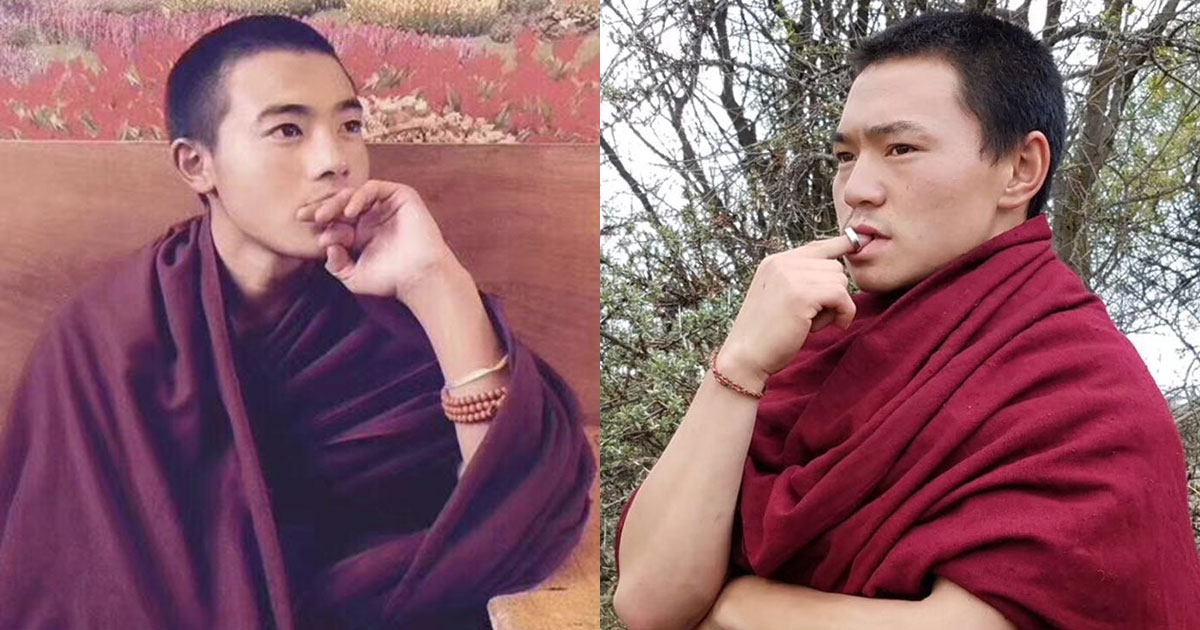
Tenzin Ghelek and Dorjee Rabten
Tenzin Gelek, Kirti monk, Ngaba county town, September 6, 2018
The next day, September 6, another monk of Kirti Monastery, 18 year-old Tenzin Gelek, staged a similar protest in the county town, calling for freedom in Tibet, according to the same sources. He was also immediately arrested and is now in detention. Tenzin Gelek, also from Me’uruma, appears to have posted two messages on social media before his protest, and is the author of many other posts under a pseudonym. It is not known where he is being detained.
Solo protest; identity unknown, Ngaba county town, September 2018
There was a third protest in September by a monk in the county town, who was arrested, but the details are not yet known.[11]
Lodoe Gyatso, Lhasa, January 28, 2018
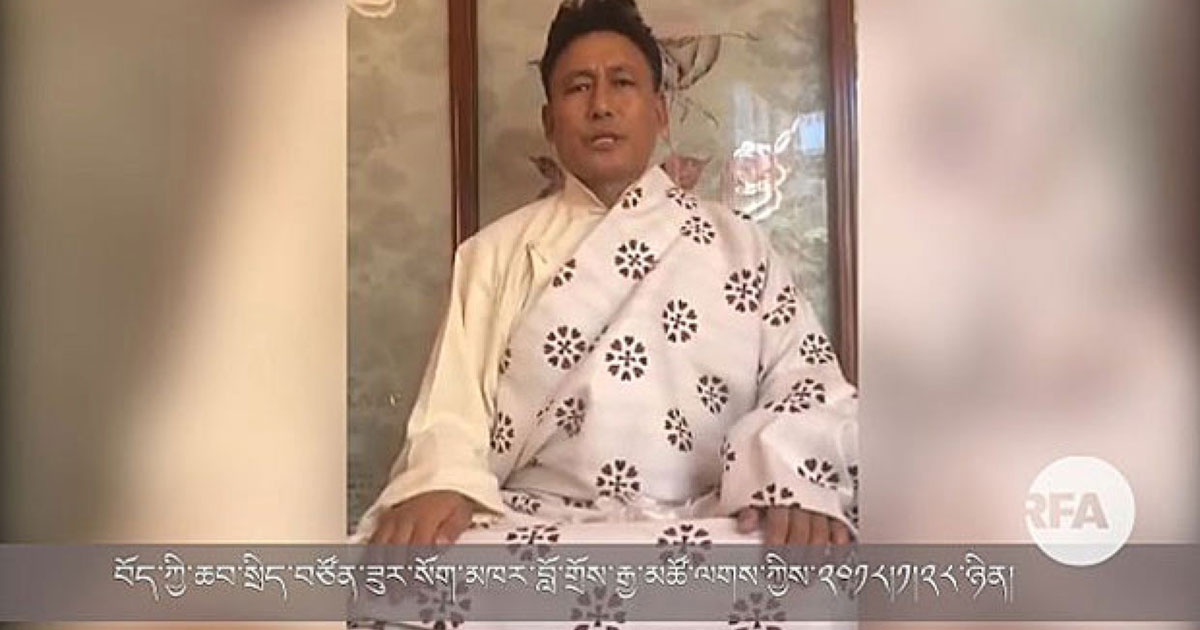
Lodoe Gyatso
The prison authorities had tortured Lodoe Gyatso severely, with a Tibetan in exile telling Radio Free Asia that: “His cell was so small that he couldn’t even raise his head, and at one point he was hung from a ceiling all night with nails driven through his thumbs.”[13] Tibetans who know Lodoe Gyatso, now in his mid-fifties, pay tribute to his strength and resilience, with fellow prisoners describing him as a courageous person with a deep sense of pride in his identity and culture.
Solo protests in 2017 monitored by ICT were as follows:
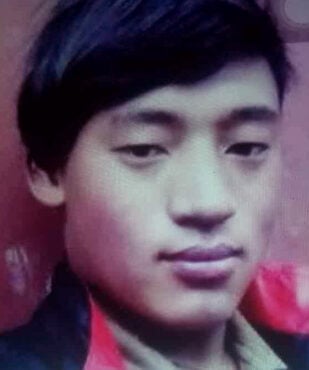
Sonam Tashi
Sonam Tashi, then 20, called for Tibet’s freedom and the long life of the Dalai Lama on January 5, 2017, in Serthar (Chinese: Seda) County in Kardze (Chinese: Ganzi) Tibetan Autonomous Prefecture, Sichuan Province (the Tibetan area of Kham). The solo protest coincided with the Kalachakra teachings given by the Dalai Lama, which was held from 3 to 14 January (2017) in India. Thousands of Tibetans from Tibet who had travelled to India and Nepal for pilgrimage and Kalachakra teachings had to return home after receiving threats of punishment from the Chinese government.
Sonam Tashi staged the protest on the main street of the Serthar County market throwing protest leaflets in the air, and shouting slogans such as “May His Holiness live for 10,000 years!” and “Freedom for Tibet!” Local police immediately overpowered him and took him away, according to the Tibetan Center for Human Rights and Democracy in Dharamsala, India.[14] Tashi’s solo protest occurred at a time when Chinese authorities had increased restrictions in the area, partly due to the Kalachakra teachings as well as the Tibetan traditional New Year (Losar) that was celebrated in late January in some parts of Tibet. Information about Sonam Tashi’s protest remained unknown for several weeks because Chinese authorities had blocked internet including WeChat messaging apps as part of widespread security clampdown in the area.
Lobsang Tsultrim, Kirti monk, Ngaba county town, February 25, 2017
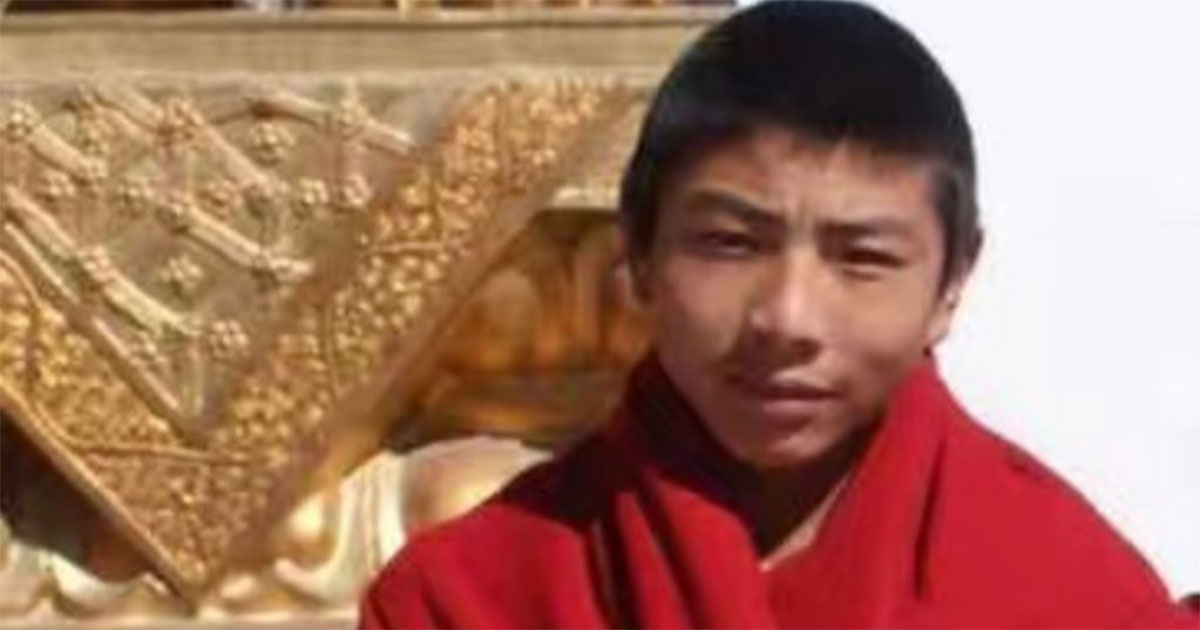
Lobsang Tsultrim
Lobsang Dargye, Kirti monk, Ngaba county town, March 16, 2017
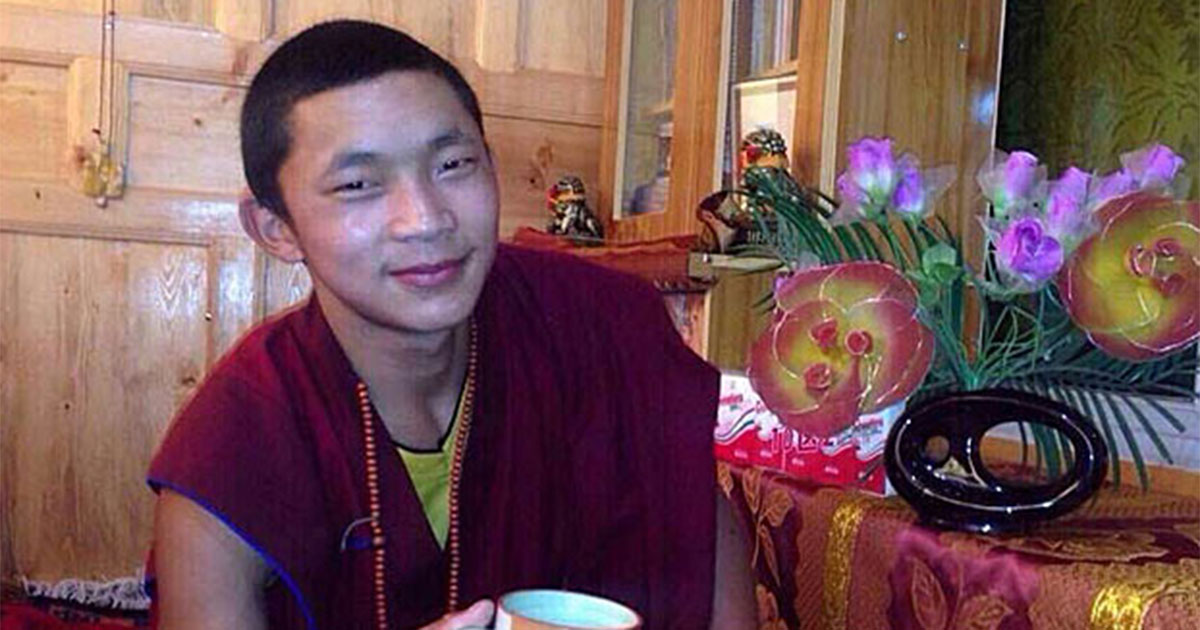
Detained monk Lobsang Dargye is shown in an undated photo. (Photo: Courtesy of an RFA listener)
Because of the political sensitivity of the March 16 anniversary of a crackdown on peaceful protesters in Ngaba in 2008, leading to a number of deaths, there was a high number of armed police in Ngaba, and Lobsang Dargye was only able to shout for a short time before being detained. A second-year student at Kirti monastery, Dargye is a native of Upper Charu township in Ngaba.
Dukpe, laywoman, Ngaba county town, March 18, 2017
A laywoman named Dukpe was taken into custody after launching a solo protest in Ngaba town on March 18 (2017), according to exile Tibetan sources. According to Radio Free Asia, “Before her protest, she was in charge of maintaining the grounds near a statue of the Buddha in front of Kirti monastery.”[17]
Unidentified Tibetan man, Lhasa, June 23, 2017
In the only known example of a solo protest in which the individual harms himself, a Tibetan man reportedly cut his throat after calling for freedom for Tibet in Lhasa on June 23, 2017. According to exile sources, the incident happened near the Jokhang Temple. The same sources said that the man was assumed to be dead, but that could not be confirmed.
Solo protests in 2016 monitored by ICT as follows:
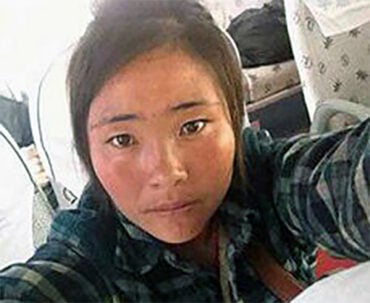
Tibetan protester Mangga is shown in an undated photo. (Photo: Courtesy of Kanyak Tsering)
A woman in her thirties named as Manga made a solo protest on March 1, 2016, marching down the main street of the town of Me’uruma in Ngaba Tibetan and Qiang Autonomous Prefecture holding up a photograph of the Dalai Lama, according to exile monks from Kirti monastery. Manga was immediately detained and taken away by police. In 2008, according to the same sources, Manga was detained for eight months and severely beaten after arguing with officials who came to compel every household in the village to fly the Chinese flag. The incident led to an increased deployment of armed forces in the Me’uruma pastoral area in Ngaba (Chinese: Aba) Tibetan and Qiang Autonomous County in Sichuan (the Tibetan area of Amdo).
Lobsang Tsering, layperson (former Kirti monk), Ngaba county town, June 7, 2016
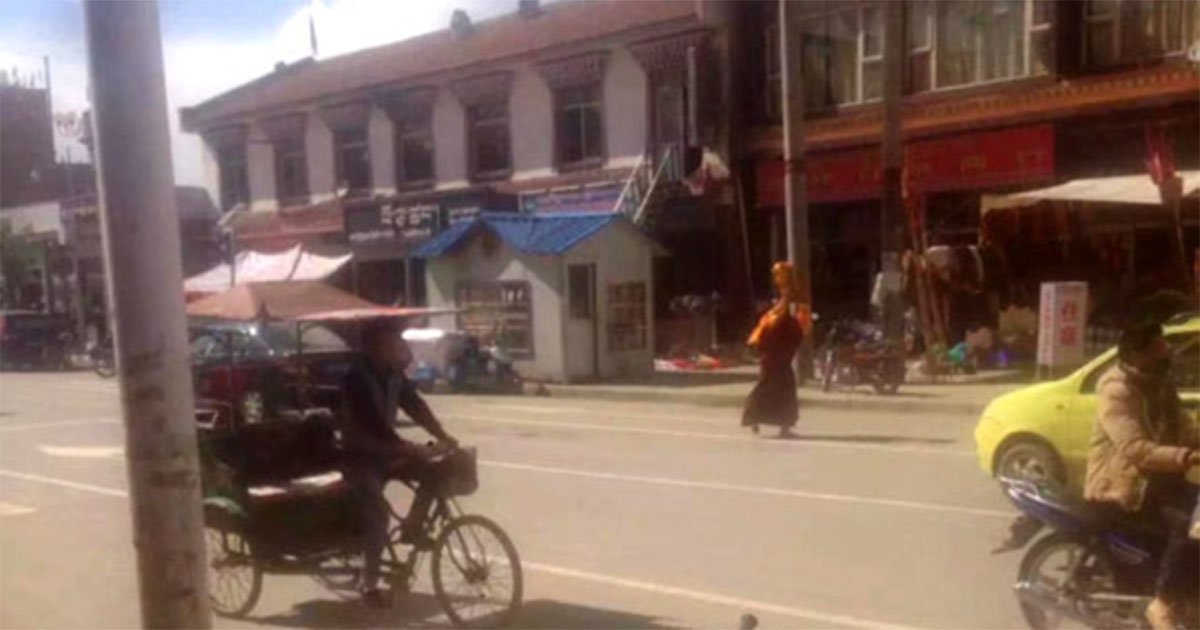
Lobsang Tsering walks down the street in Ngaba holding a portrait of the Dalai Lama.
Kunchok Dolma, laywoman, Ngaba county town, July (date unknown), 2016
Kunchok Dolma walked down the street known locally as Heroes Road carrying a portrait of the Dalai Lama and was immediately arrested by the police. The news of her arrest was delayed due to restrictions on communication channels in Ngaba, according to exile Tibetan sources.
Lobsang Tsultrim, Kirti monk, Ngaba county town, October 17, 2016
Lobsang Tsultrim was beaten so badly by police after staging his solo protest that he was admitted to hospital with severe injuries. “He called out for Tibetan freedom and for the long life of [exiled spiritual leader] the Dalai Lama as he walked, and when he arrived at the street in front of the Tibetan Language Middle School he was stopped by police and taken away,” Radio Free Asia reported on October 20, 2016. Two days later, Chinese police went to Kirti to question monks about the incident, and the presence of police and security officers was strengthened.
Tenpa, former Kirti monk, Ngaba county town, December 16, 2016
Tenpa, an 18-year old Tibetan from Me’uruma, carried out a solo protest in Ngaba on December 16, 2016, on the road known as ‘Martyrs’ or ‘Heroes’ street where the self-immolations began near Kirti monastery. According to Tibetans living in exile with contacts in the region, Tenpa held out a Tibetan national flag with a portrait of His Holiness the Dalai Lama in the center of the street and shouted slogans calling for the Dalai Lama’s return to Tibet and for a free Tibet. Within minutes, a group of Chinese policemen took him away, kicking and punching him as they did so.
Lobsang Thubten, Kirti monk, Ngaba county town, May 2, 2016
Lobsang Thubten, believed to be in his twenties, was detained shortly after launching a protest on May 2 on ‘Heroes Street’ in Ngaba county town. “He walked in the road with a photo of [exiled spiritual leader] the Dalai Lama and called for his long life and for freedom for Tibet,” according to Radio Free Asia on May 3, 2016. He was detained immediately afterwards.
Solo protests in 2015 monitored by ICT as follows:
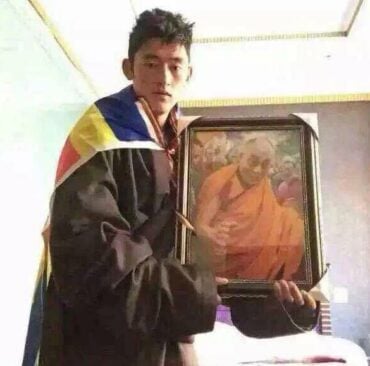
Tashi Dhondup, who demonstrated in Dzoege, Ngaba, on December 19. This image, circulating on social media, appears to have been taken before his protest and shows him holding the image of the Dalai Lama he displayed during his solo demonstration.
Tashi Dhondup walked along a road in Dzoege county town on December 19, 2015, wearing traditional Tibetan dress and bearing a photograph of the Dalai Lama, with a Buddhist flag on his back. Footage circulating on social media shows him running and walking along the street bearing the large picture of the exiled religious leader. According to Tibetan sources, he was detained by armed police shortly after the footage was shot. Tashi Dhondhup was born in Thangkor Township, Dzoege County.[18]
Pema Dorje, Tibetan monk from Za Gonsar Monastery in Derge (Chinese: Dege) County, Kardze (Ganzi) Tibetan Autonomous Prefecture, Sichuan, February 6, 2015
Pema Dorje was arrested by police whilst carrying out a solo protest in Kardze County, Sichuan Province on 6 February 2015, according to Free Tibet in London. The 17 year-old was heard shouting slogans of “Long Live His Holiness the Dalai Lama” and “Return His Holiness the Dalai Lama to Tibet”. Witnesses report around eight police officers beating him, badly injuring his face.[19]
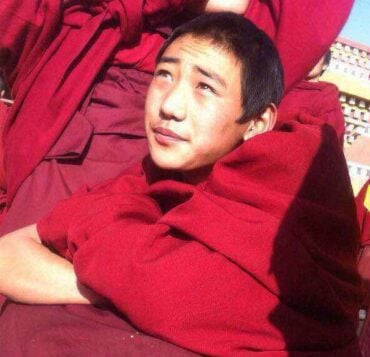
Kirti monk Gendun Phuntsok, sentenced to four years in prison following his solo protest in March (2015).
Gendun Phuntsok, then 18, staged a protest in Ngaba county town on March 8 (2015), marching with a portrait of the Dalai Lama wrapped in a yellow khatag (greeting scarf) held to his head and shouting “Let the Dalai Lama return! Freedom and equality for Tibet,” according to the Kirti monks in exile. Gendun Phuntsok is from the Chukle Gabma pastoral area in Cha village; he joined Kirti monastery as a child and graduated from the preliminary class last year. At the end of October in 2015 Gendun Phuntsok was sentenced to four years in prison, and was taken to Mianyang prison near Chengdu where most of the political prisoners in Sichuan are held.
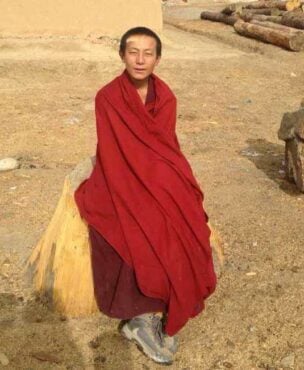
Kirti monk Losang Kelsang, sentenced to three years in prison for his solo protest in March (2015).
Losang Kelsang, the cousin of Gendun Phuntsok (above) protested on March 17, on the streets of Ngaba, holding up a portrait of the Dalai Lama in one hand and scattering lungta (paper slips printed with prayers) while chanting “Freedom for Tibet!” He is also from Chukle Gabma and joined Kirti monastery at an early age. On November 2, 2015, Losang Kelsang, was sentenced to three and a half years by the same court as his cousin in Li county, Ngaba prefecture, and taken to Mianyang prison. He was released on September 17 [2018], and then detained by the Me’uruma police for five days for‘re-education’, according to the Kirti monks in exile in Dharamsala.
Unidentified Tibetan, Lithang (Chinese: Litang), Kardze, August 18, 2015
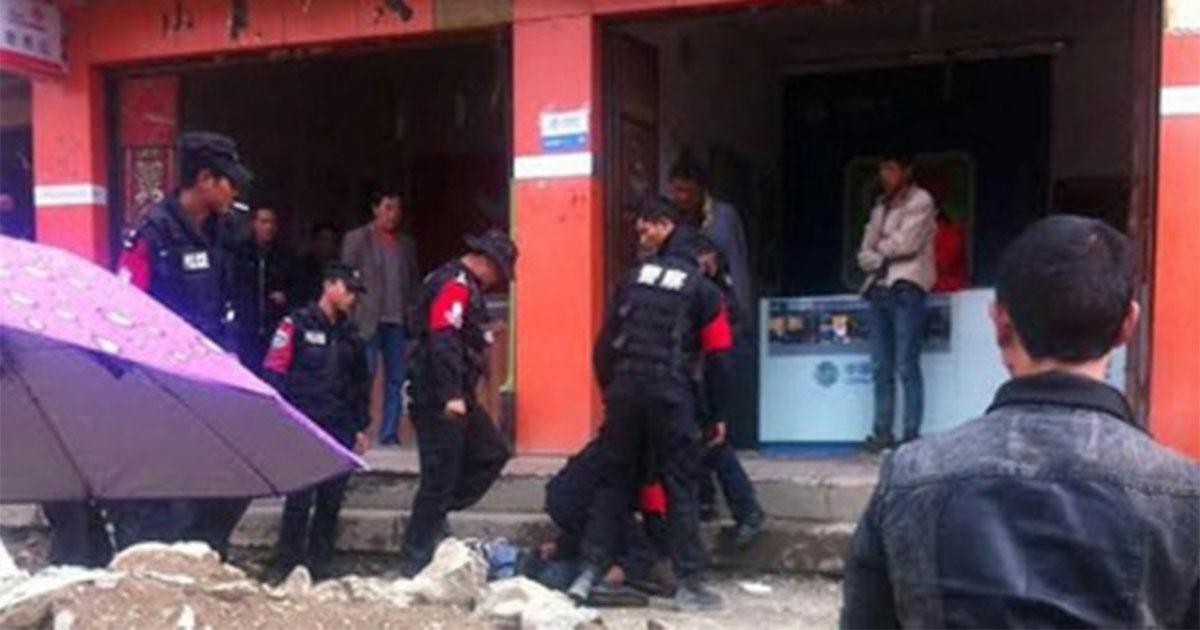
Police detain a Tibetan protester in Lithang, Sichuan, Aug. 18, 2015. (Photo: Courtesy of an RFA listener)
Tashi, layman, Ngaba county town, October 26, 2015
On October 26, 2015, a 31-year old layman named Tashi staged a peaceful protest on the main street of Ngaba county town, marching down the street holding a photo of the Dalai Lama and shouting “Freedom for Tibet! The Dalai Lama must return!” He was arrested by the police on duty and taken away. Tashi lives with his wife’s family in the Me’uruma pastoral area, and he and his wife have four children.
Losang Jamyang, Kirti monk, Ngaba county town, September 23, 2015
At about 4 pm on September 23, 15-year old monk Losang Jamyang staged a protest march, along the main road from ‘Heroes’ street (outside the Kirti monastery) towards Ngaba county town, shouting “Freedom for Tibet! The Dalai Lama must return!” He was immediately arrested by the police and taken away. Losang Jamyang is also from the Me’uruma pastoral area and joined Kirti monastery as a child.
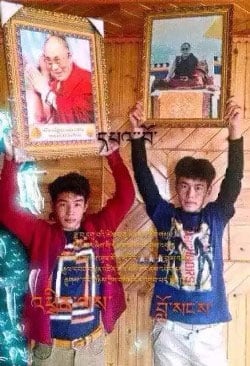
Trinley (left) and Lobsang in an undated photograph/photo.
At around midday on September 10, two young Tibetan males called Trinley and Losang marched down the main street of the county town shouting “Freedom for Tibet! May the Dalai Lama live 10,000 years!” They were arrested and taken away. Both are from Soruma village in Choejema township of Ngaba county, but no further details are known.[21]
Lobsang Drakpa, Kirti monk, Ngaba, September 10, 2015
Lobsang Drakpa, 20, also known as Adrak, staged a protest in Ngaba County’s main town, calling loudly for Tibetan freedom before he was taken away, according to exile Tibetan sources. Radio Free Asia reported that: “When Lobsang Drakpa was taken away, some Tibetans who witnessed the scene clashed with police, but no details regarding injuries or detentions are known.[22] Lobsang Drakpa is reported to have been sentenced to three years imprisonment in an undisclosed trial.
Losang, Kirti monk, Ngaba, September 10, 2015
At about 6 pm, 22 year old Kirti monk Losang staged a similar protest in the main street of the county town, and was immediately arrested. Losang, who is from the Chukle Gabma pastoral area, joined Kirti monastery at a young age, and had been studying in the logic class.
Jampal Gyatso, Kirti monk, Ngaba, September 9, 2015
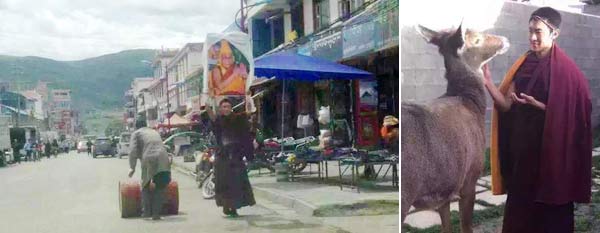
(Left) Jampal Gyatso’s protest on September 9, holding up a large portrait of the Dalai Lama wrapped in a blessing scarf (khatag) and calling for freedom for Tibet. (Right) Jampal Gyatso, who protested in the main street of Ngaba county town on September 9.
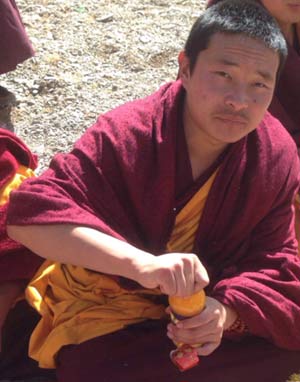
Losang Kalsang, who protested on September 7.
September 7, 2015
At about 3 pm on September 7, 19-year old Kirti monk Losang Kalsang staged a protest in Ngaba county town, shouting “Freedom for Tibet! May the Dalai Lama live 10,000 years!” and other slogans of protest against the Chinese government. He was taken away by police. Remarkable footage shows him walking along the street with a picture of the Dalai Lama held high. As police move in, they grab the picture, dropping it to the ground, and surround him, dragging him away. As he is taken away, Tibetan onlookers call and whoop in his support.
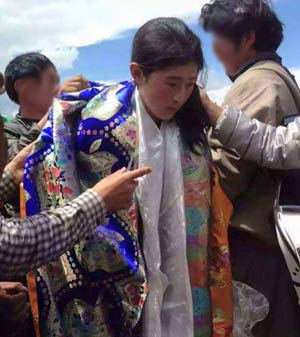
Wangmo on her arrival at Meuruma, Ngaba County.
Wangmo, in her early twenties, was detained after a solo protest on July 15, 2015 in Me’uruma village, Ngaba, after she called for the return of the Dalai Lama to Tibet and freedom for Tibetans. Her release from custody was reported on July 23, 2015, by exile Tibetan sources; an image of her upon release shows her draped in khatags by local people to demonstrate their respect for her actions.
Tashi Kyi, laywoman, Me’uruma, Ngaba, July 2, 2015
On July 2 2015 another Tibetan woman named Tashi Kyi, 20, was arrested by Chinese authorities in Me’uruma. The detention is believed to have been related to some activities, possibly a demonstration, that took place at the 80th birthday celebration of the Dalai Lama in Me’uruma Township.
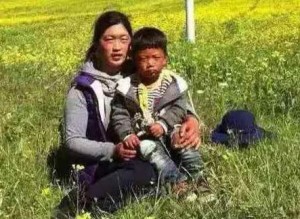
Wokar Kyi, with her son, who protested on August 15, shouting “Freedom for Tibet”, “We have suffered too much repression” and “The Dalai Lama must return.”
A month later, on August 15, Wokar Kyi shouted “Freedom for Tibet”, “We have suffered too much repression” and “The Dalai Lama must return”, also in Me’uruma town. She was immediately arrested by local police and taken away.
Dorje Drolma, laywoman, Ngaba county town, August 20, 2015
At around 8.30 am on August 20, a 29-year old woman named Dorje Drolma staged a protest in the main street of Ngaba county town, walking along the road and shouting slogans against Chinese government oppression. She was immediately detained by around 10 policemen.
Incidents of solo protest monitored by ICT in 2014 are as follows:
Lobsang Gyatso, Kirti monk, Ngaba, April 2, 2014
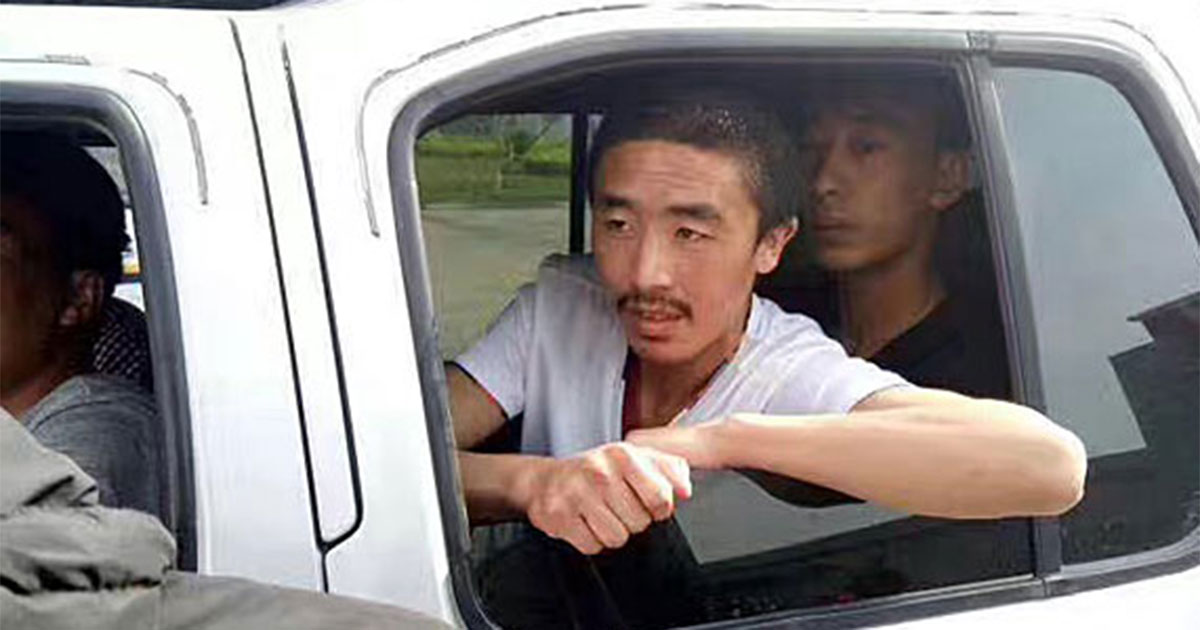
Lobsang Gyatso after release from prison. (Photo: TCHRD)
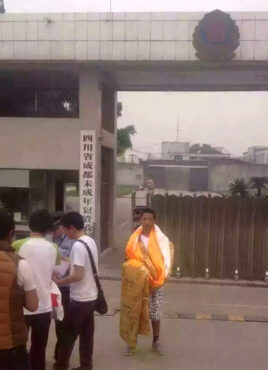
Lobsang Tenpa wearing khatas (Tibetan ceremonial scarves) in a photo taken outside the prison facility where he spent two years.
The then 19-year old Lobsang Tenpa, a classmate of Lobsang Gyatso’s from Kirti monastery, staged a solo protest in the main street of Ngaba county town on April 26, 2014. He walked along ‘Heroes Road’ with a Tibetan national flag wrapped around his head and displaying a photograph of the Dalai Lama. Lobsang Tenpa was immediately detained, and sentenced to two years imprisonment on November 24, 2014, for organizing “anti-national activities”, according to the Tibetan Center for Human Rights and Democracy.[24] He was released in May 2016 from a juvenile prison facility, after being detained incommunicado at first for about eight months during which he was subjected to beatings and torture. Losang Tenpa comes from Me’uruma township, in Ngaba, and joined Kirti monastery at a young age. He has two older half-brothers who are both monks.
Lobsang Tinley, Kirti monk, Ngaba county town, December 26, 2014
Lobsang Tinley, then 21, staged a solo demonstration on December 26, 2014 on the main street of Ngaba county town. He was immediately detained.
Jampa Sengge, layman, Kardze (Ganzi) county town, November 28, 2014
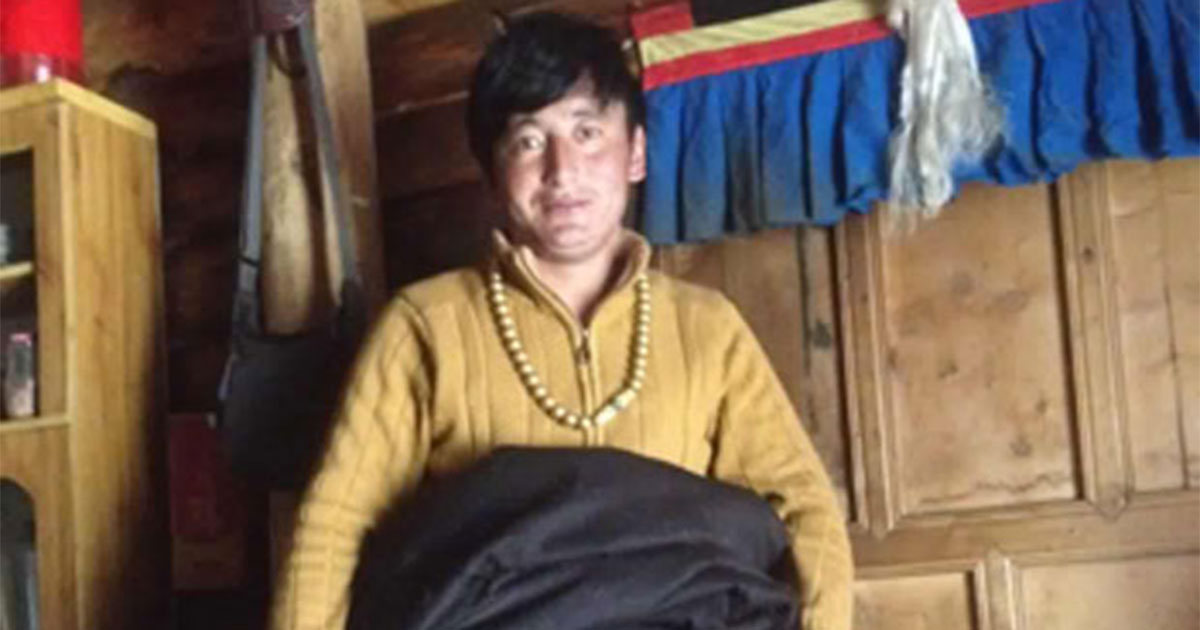
Tibetan protester Jampa Sengge is shown in an undated photo. (Photo courtesy of an RFA listener)
Dorje Rinchen, layman, Serthar (Chinese: Seda), Kardze, October 2014
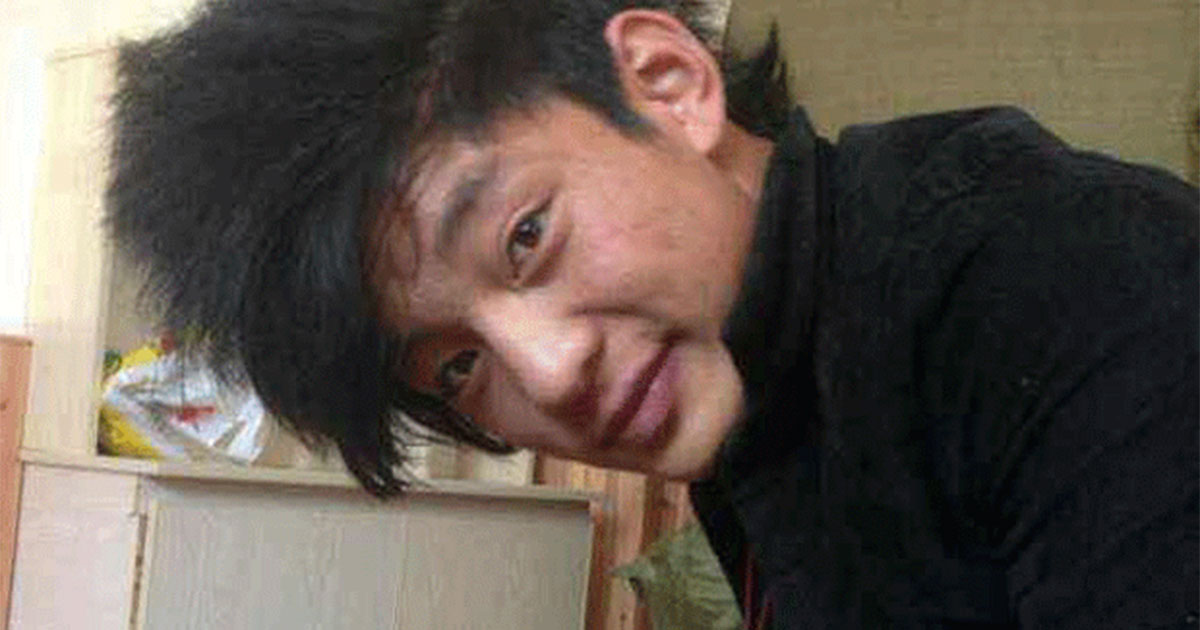
Tibetan protester Dorje Rinchen in an undated photo. (Photo courtesy of an RFA listener)
Pasang Wangchuk, layman, Kardze, October 3, 2014
On October 3 (2014), Pasang Wangchuk, a Tibetan businessman and father of three was detained in Kardze prefecture after a solitary protest challenging Beijing’s rule in Tibetan areas, according to sources.
Footnotes:
[1] Adrian Zenz for China Brief, Jamestown Foundation, ‘China’s Domestic Security Spending: An Analysis of Available Data’, Vol XVIII, Issue 4, March 12, 2018, https://jamestown.org/program/chinas-domestic-security-spending-analysis-available-data/
[2] International Campaign for Tibet report, ‘Acts of Significant Evil’, https://www.https://savetibet.org/acts-of-significant-evil-report/
[3] International Campaign for Tibet report, ‘Tibetan man dies after self-immolation; oppressive measures intensified in March 10 anniversary week’, March 7, 2018 https://www.https://savetibet.org/tibetan-man-dies-after-self-immolation-oppressive-measures-intensified-in-march-10-anniversary-week/
[4] Tibet Daily, March 4, 2018, article entitled: ‘The autonomous regional stability supervision group supervised the maintenance of stability work in Changdu’, in Chinese at: http://www.gem.xizang.gov.cn/sy/xzxw/201803/t20180304_44796.html
[5] Adrian Zenz for China Brief, Jamestown Foundation, ‘China’s Domestic Security Spending: An Analysis of Available Data’, Vol XVIII, Issue 4, March 12, 2018, https://jamestown.org/program/chinas-domestic-security-spending-analysis-available-data/
[6] International Campaign for Tibet factsheet on self-immolations, https://www.https://savetibet.org/resources/fact-sheets/self-immolations-by-tibetans/
[7] Radio Free Asia, ‘Two Tibetan Monks Self-Immolate on Crackdown Anniversary’, March 15, 2014, https://www.rfa.org/english/news/tibet/burning-03162014125839.html
[8] The letter appeared on website forums and blogs on February 16, 2012 and was circulated widely; it also appeared in Tibetan on Tibetan blogs but were promptly taken offline. The letter is highly critical of Shi Jun and is an unusually frank and outspoken piece of writing from a Tibetan official, translated into English by High Peaks Pure Earth: http://tibet.net/2018/09/an-open-letter-by-a-tibetan-cadre-high-peaks-pure-earth/
[9] For context on the wave of self-immolations in Ngaba and beyond, see ICT report, ‘Storm in the Grasslands: Self-Immolations in Tibet and Chinese Policy’ https://savetibet.org/storm-in-the-grasslands-self-immolations-in-tibet-and-chinese-policy/
[10] Ganzi Daily, January 4, 2008. Kardze, one of 18 counties in the prefecture, has been the site of more known political detentions of Tibetans than any other county outside the Tibet Autonomous Region (TAR) since the late 1980s.
[11] International Campaign for Tibet report, ‘Three Tibetan monks in Ngaba hold peaceful protests in a resurgence of solitary demonstrations’, September 25, 2018, https://www.https://savetibet.org/three-tibetan-monks-in-ngaba-hold-peaceful-protests-in-a-resurgence-of-solitary-demonstrations/
[12] Lodoe Gyatso, who is known for his mental and physical toughness, withstanding severe torture during over 20 years in prison, carried out his first protest in Lhasa’s Drapchi prison in 1995. Lodoe Gyatso had been serving a 15-year prison term for killing a man who had attacked him in a fight, but during his incarceration met various political prisoners and was inspired to protest inside prison. International Campaign for Tibet report, ‘Tibetan who survived more than 20 years imprisonment disappears after bold protest for peace’, February 8, 2018, https://www.https://savetibet.org/tibetan-who-survived-more-than-20-years-imprisonment-disappears-after-bold-protest-for-peace/
[13] Radio Free Asia report, May 31, 2016, https://www.rfa.org/english/news/tibet/vanishes-05312016154810.html
[14] TCHRD, February 20, 2017, http://tchrd.org/tibetan-youth-detained-for-staging-peaceful-protest-during-chinese-ban-on-dalai-lamas-teachings/
[15] Voice of America Tibetan services, February 26, 2017, https://www.voatibetanenglish.com/a/3739873.html
[16] Radio Free Asia report, https://www.rfa.org/english/news/tibet/separate-03202017153530.html
[18] Further details on the solo protests in 2015 are included in this International Campaign for Tibet report, ‘Wave of solo peaceful protests in Ngaba: repression and further restrictions imposed’, September 28, 2015, https://www.https://savetibet.org/wave-of-solo-peaceful-protests-in-ngaba-repression-and-further-restrictions-imposed/ and also ‘New solo protest by young man in Ngaba is part of emerging trend’, December 21, 2015, https://www.https://savetibet.org/new-solo-protest-by-young-man-in-ngaba-is-part-of-emerging-trend/
[19] Free Tibet online, February 10, 2015, https://freetibet.org/news-media/na/17-year-old-tibetan-beaten-after-solo-protest
[20] Radio Free Asia report, August 19, 2015, https://www.rfa.org/english/news/tibet/solo-08192015133401.html
[21] Although they carried out their protest at the same time, ICT has included this demonstration in this report. Also see Phayul.com, October 5, 2015, http://www.phayul.com/news/article.aspx?id=36567&t=1
[22] Radio Free Asia Tibetan service, September 11, 2016, https://www.rfa.org/english/news/tibet/solo-09112015164530.html
[23] TCHRD report, April 28, 2017, http://tchrd.org/tibetan-monk-jailed-for-peaceful-protest-released-after-three-years/
[25] November 30, 2014, https://www.rfa.org/english/news/tibet/solo-11302015142320.html
[26] RFA, October 17, 2014, https://www.rfa.org/english/news/tibet/youth-10172014135212.html

